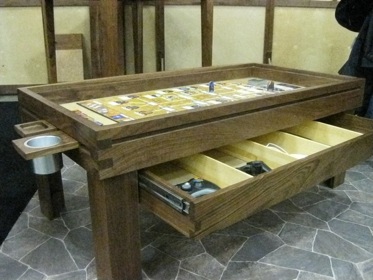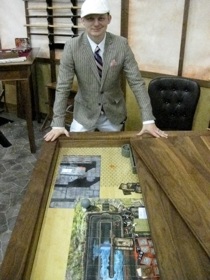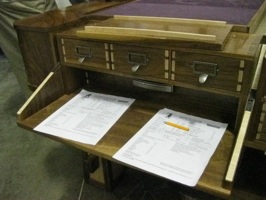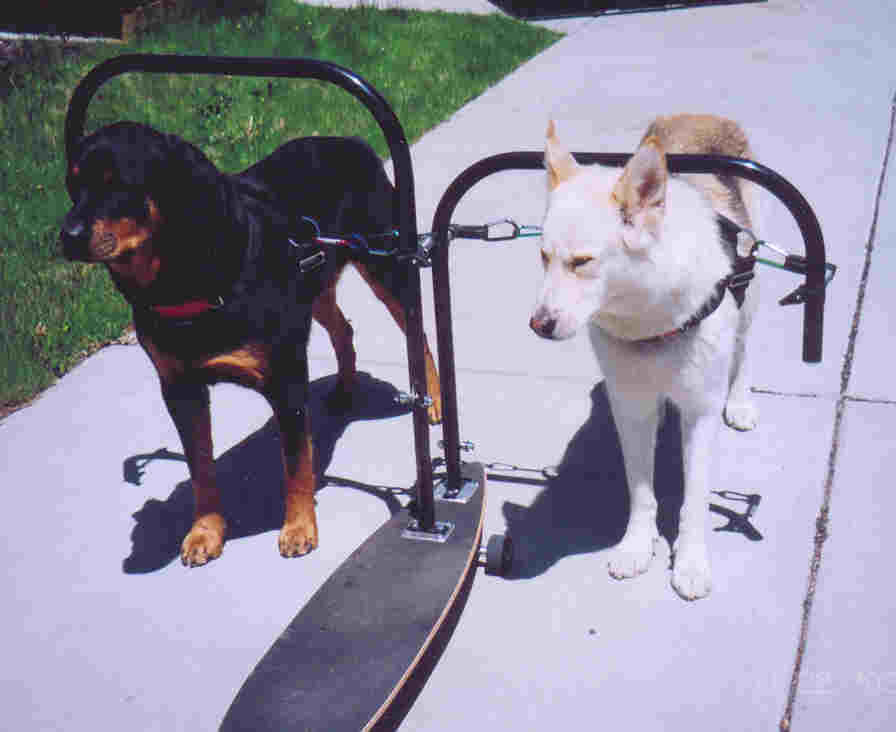The Latest from Boing Boing |  |
- Have you ever bought a gadget that your dog actually needed?
- Patrick Farley vows to return to webcomics
- Late Age of Print collaborative audiobook project
- Pew Pew $6 raygun tee
- The kingdom where women rule
- Home made lapsteel guitar
- Subways to, or at least near, the seas
- Photographer who shot default iPad wallpaper tells his tale
- Craigslists of greatness: ISO L/T BROMANCE
- FCC loses big in court's Comcast ruling over Net Neutrality
- Of coal mines and methane
- Odd search queries
- A 2.5 Year-Old Has A First Encounter with An iPad
- Plants Vs Zombies characters recreated as lawn ornaments
- Custom furniture for gamer geeks
- Game Boy costume for dogs
- Disconcerting disclosure on McDonald's site
- Mondo 2000: An Open Source History
- LSD and the birth of the PC
- 2010: Smudge Odyssey
- Music video with a whole school as the instrument
- Roland MicroCube Portable Guitar Amplifier
- Confessions of a hardcore instant ramen lover
| Have you ever bought a gadget that your dog actually needed? Posted: 06 Apr 2010 11:34 PM PDT  Vet visits aside, dogs require no gadgets. Yet the supply of 'canine' techno-doodads only grows, as evidenced by the pitches that accumulate in the delete box, requesting that this or that new animal-machine be 'reviewed.'
PetCell is a similar offering, but allows you to actually call your pet and speak to it, too. Sit! I can see that working, but only if the animal were trained appropriately -- would many of us do so? But there's the rub: you're buying yourself an idea whose successful execution depends on many other things. And so it is with pet tech, where we disengage ourselves in increments from our furry friend's real needs and enter the world of our own whims.
 Take, for example, the $3,000 canine treadmill, especially designed for people who spend lots of money on their pets. Or a $5,000 therapeutic whirlpool dog bathtub, complete with VetSling. You might also consider outsourcing the love to Wag, a pet hotel Lisa Katayama says "promises the ultimate in canine luxury." Among the technological delights: flatscreen television, a networked camera for remote pet-welfare inspection, and an atmospheric filtration system. Arugula for rabbits! Is this Pet Doorbell Behold the machine that makes ice cakes for dogs, or the $250 speaker system that is also compatible with horses. And did you know there was postmodern furniture for pets? Not a gadget, I know. But it's still the same basic idea: pay lots of money to validate one's personal bond to an inscrutable beast, which in this case would prefer to recline on an Ettore Sottsass shelf. You know how Tamagotchi and Nintendogs are like pale, sad shadows of the real thing? TheSnif Tag goes one better, turning the chop-licking joy of a real animal companion into a series of neat statistical charts for you to examine while it begs for your attention. It's an accellerometer and RFID collar-tag that transmits 'motion data' to a base station; so armed, you can quantify your dog's daily routines. More fun is the Pets Eye View Camera, a tiny dangly box which hangs from Rover's collar and snaps ground-level pictures at 1, 5 or 15 minute intervals. Caveats: the pictures are 0.3 megapixels and poor quality, and there's only enough space for 40 of them. A skilled maker could easily make something better. Pictured above is a $555 dog-powered scooter, trike and skateboard system, presented here without comment.
There is, however, a final item whose utility is clear: Bissell's Spotbot Pet edition, a mini spot cleaner that sqirts stains, brushes them clean and slurps the mess into an easily-cleanable tank. It works great on "puke, pee, or butt juice," and is $130 at Amazon.
|
| Patrick Farley vows to return to webcomics Posted: 06 Apr 2010 09:07 PM PDT Hurrah! Patrick Farley, creator of the genius abandonware webcomic Electric Sheep, is back on the job and promising to continue the series. But first he needs to raise $6,000 on Kickstarter to take the time off to work on it. Electric_Sheep Reloaded (Thanks, Dawn!) Previously: |
| Late Age of Print collaborative audiobook project Posted: 06 Apr 2010 09:02 PM PDT Kewbrew sez, "Ted Striphas, who Creative Commons-licensed his excellent The Late Age of Print, is now doing an open source audiobook project for his book. It's a great, smart read, and you can also check out the book free online as well." |
| Posted: 06 Apr 2010 09:13 PM PDT  Em sez, "Really cool t-shirt up on 6 Dollars - a ray gun (filled with space imagery) shooting 'pew pew pew'." Space Hero (pew pew pew) by soundsalker (Thanks, Em!) |
| Posted: 06 Apr 2010 07:47 PM PDT Women are barred from being rulers in most of northern Nigeria. Except in the kingdom of Kumbwada, which has had a queen for generations. Why the exception? Tradition says that any man who tries to take the throne will die. Today, Queen Hajiya Haidzatu Ahmed doles out justice for abused wives, tries to prevent divorce and weathers the rumblings from nearby imams that her kingdom's custom amounts to witchcraft. |
| Posted: 06 Apr 2010 06:35 PM PDT |
| Subways to, or at least near, the seas Posted: 06 Apr 2010 06:15 PM PDT  If you're ever suspected that there must be a theoretical sweet spot where the fantasies of design nerds and transit nerds converge, this is it: Transit Authority Figures, a side project of the Massachusetts design firm Rob & Damia. TAF specializes in beautiful maps for fictional subways in places where the construction of actual subways would likely doom everyone involved -- watery spots like Rehoboth/Ocean City or Cape Cod & The Islands, seen here. The maps are inspired by the iconic London Tube diagram designed by Harry Beck in 1931 and updated over the years. Originally designed as client gifts, they're now available online. (Via Coudal Partners.) |
| Photographer who shot default iPad wallpaper tells his tale Posted: 06 Apr 2010 03:21 PM PDT Richard Misrach, the photographer who shot the image Apple decided to use for default iPad wallpaper—an idyllic desert lake, in Nevada—tells the funny story of how that deal came to be. "I was in bed watching Inglorious Basterds when I got a call from (...) my dealer in San Francisco, and he said, 'Do you know what's going on live here?' I was totally shocked. Naturally my other galleries started calling and my family was all atwitter, because it's a whole different world." |
| Craigslists of greatness: ISO L/T BROMANCE Posted: 06 Apr 2010 03:07 PM PDT A Craigstlist ad of greatness: "looking for a long-term bromance / friend without benefits after having given up on girls." (thanks, Bobby Ciraldi) |
| FCC loses big in court's Comcast ruling over Net Neutrality Posted: 06 Apr 2010 02:59 PM PDT  (IMAGE: Drudge, ever the drama queen, leads with this story as I publish this post.) (IMAGE: Drudge, ever the drama queen, leads with this story as I publish this post.) A US federal appeals court has ruled that the FCC doesn't have the authority to force broadband providers to treat all internet traffic equally, and that blocking or slowing certain services—say, BitTorrrent—for anti-competitive reasons is okay. The ruling basically tells the FCC that it has no authority to regulate the activities of internet service providers, just as the agency prepares to launch a nationwide broadband agenda. After Comcast's blocking [of BitTorrent] was exposed, the F.C.C. told Comcast to stop discriminating against BitTorrent traffic and in 2008 issued broader rules for the industry regarding "net neutrality," the principle that all Internet content should be treated equally by network providers. Comcast challenged the F.C.C.'s authority to issue such rules and argued that its throttling of BitTorrent was necessary to ensure that a few customers did not unfairly hog the capacity of the network, slowing down Internet access for all of its customers.News coverage today: New York Times, Washington Post, NPR, Torrentfreak, Cnet, Wired News. What does this mean to you? From Ryan Singel's Wired News piece: A broadband company could, for instance, ink a deal with Microsoft to transfer all attempts to reach Google.com to Bing.com. The only recourse a user would have, under the ruling, would be to switch to a different provider -- assuming, of course, they had an alternative to switch to.Some argue the ruling is a good thing: Kevin Werbach tweeted, "My quick read of the Comcast opinion: it's as positive for the FCC as a reversal could be. Leaves lots of room to maneuver." Dan Gillmor argues that the responsibility for ISP oversight has always been the job of Congress, anyway. See also this piece at Techdirt. Here's a link to the FCC ruling (PDF). |
| Posted: 06 Apr 2010 02:27 PM PDT  Yesterday, an explosion in the Upper Big Branch Mine in Montcoal, West Virginia, killed 25 miners. Four others are still missing. It's the largest mining disaster the U.S. has seen in decades. The explosion was massive. "Rails used to move heavy equipment inside the mine were left 'twisted like pretzels' by the force and heat of the blast," according to the Washington Post. Right now, nobody knows what caused the blast, but one likely candidate is a build-up of methane—natural gas—in the mine. I called Christopher Bise, Ph.D., chair of West Virginia University's Mining Engineering department, to find out how methane gets into the mines, why the weather matters for mine safety and how one of the best ways to protect miners from methane can actually improve the mine's bottom line. Maggie Koerth-Baker: How does methane get into the mines to begin with? MKB: Why is it only dangerous in that narrow range? MKB: What about the ignition source? Where does that come from? I'm sure they're pretty careful about open flames down there. MKB: Are there characteristics that make a methane explosion more likely? MKB: Is there any reliable way to remove methane from coal mines, or is it a fact of life that you can mitigate, but not really control? For more information on yesterday's disaster, check out this live-chat interview with Jeff Goodell, author of Big Coal: The Dirty Secret Behind America's Energy Future. He's got a lot of insight into the politics side of mine safety. Vintage postcard image of coal miners comes from the Flickr stream of j3net. |
| Posted: 06 Apr 2010 03:39 PM PDT There is at least one blog comprising solely of the search queries used to find That last one should be a Gary Numan song! Also, can you guess what rank is occupied by people who typed the actual domain name into Google? We have had hundreds of thousands of those. |
| A 2.5 Year-Old Has A First Encounter with An iPad Posted: 06 Apr 2010 11:42 AM PDT My friend Todd Lappin says: "A fascinating UI experiment. My daughter likes playing with my iPhone, but this was her very first encounter with an iPad. As you'll see, she took right to it... although she too wonders why it doesn't have a camera!" As Rob Beschizza observes: "The perfect rorschach test for liking or hating the iPad -- a UI so perfect and natural even a kid can use it / a UI so dumbed-down that even a kid can use it." |
| Plants Vs Zombies characters recreated as lawn ornaments Posted: 06 Apr 2010 11:16 AM PDT |
| Custom furniture for gamer geeks Posted: 06 Apr 2010 11:33 AM PDT    Geek Chic is a Seattle-based company that creates custom, handcrafted furniture for gamer geeks, such as formal dining room tables that convert to gaming tables and the Alexandria Codex, "a storage system that brings our comic and card collections into the areas we live and gives them a home that befits their importance. Company founder Robert Gifford showed off his latest creations at WonderCon, where Youth Radio's Noah Nelson interviewed him. WonderCon: Geek Chic Geek Chic is a Seattle-based company that creates custom, handcrafted furniture for gamer geeks, such as formal dining room tables that convert to gaming tables and the Alexandria Codex, "a storage system that brings our comic and card collections into the areas we live and gives them a home that befits their importance. Company founder Robert Gifford showed off his latest creations at WonderCon, where Youth Radio's Noah Nelson interviewed him. WonderCon: Geek Chic |
| Posted: 06 Apr 2010 11:10 AM PDT  [via Etsy] |
| Disconcerting disclosure on McDonald's site Posted: 06 Apr 2010 11:12 AM PDT  My friend Jason Tester noticed this on the front page of Ronald.com, an official McDonald's site. While it's good that they have such a prominent disclosure statement, it somehow feels like a parody of itself, very Adbusters-ish. The period after "Hey kids" feels particularly disconcerting. UPDATE: Responding to a request in the comments from scifijazznik, Rob B created this freakish bit of Photoshoppery. Previously: |
| Mondo 2000: An Open Source History Posted: 06 Apr 2010 10:31 AM PDT  In the cyberdelic daze of the early 1990s, Mondo 2000 was the publication-of-record. Founded by our dear pal RU Sirius, it was not just a magazine (with an expiration date), but a "strange attractor" for freaks interested in the new edge of computers, pranks, digital art, fringe culture, psychedelics, consciousness, weird science, and hacking. In fact, Mondo was one of the main magnets that drew me to San Francisco in 1992. To chronicle the Mondo moment and its impact, RU has launched a new project to create a Web history and book, and he's created a Kickstarter page to gather funding to make it happen. From the project page for Mondo 2000: An Open Source History (cover gallery above from Mondo2000.net): MONDO 2000: An Open Source History |
| Posted: 06 Apr 2010 10:29 AM PDT  CIO magazine presents a quick taste of the well-documented links between the emergence of Silicon Valley and psychedelic culture. The full story is documented in John Markoff's excellent book What the Dormouse Said: How the Sixties Counterculture Shaped the Personal Computer Industry. It was definitely a long strange trip. From CIO magazine: Silicon Valley's rise as the hub of the technology industry in the 1960s coincided with LSD's explosion on the cultural scene. Within a few miles of Stanford Research Center (SRI), where Douglas Englebart was envisioning the personal computer as a mechanism to "augment human intelligence," three organizations were then legally administering LSD to guinea pigs. The Veterans Administration Hospital in Menlo Park and the Palo Alto Mental Research Institute were studying LSD to better understand schizophrenia. Meanwhile, the International Foundation for Advanced Study, founded by a former engineer, sought to give credibility to LSD's mind-expanding properties. These organizations offered leaders of the counterculture (Ken Kesey, Allen Ginsberg) and some of the personal computer industry's founding fathers their first communions with acid. No doubt, their mind-blowing experiences influenced the communal ethos of the early personal computing industry and later the open source software movement.Tech Visionaries and LSD: Turn On, Tune In, Geek Out |
| Posted: 06 Apr 2010 09:25 AM PDT  Xeni reminded me how with each iteration, the monolith gets bigger. But one thing stays the same -- what it ends up looking like after sapient apes get their hands on one. Xeni reminded me how with each iteration, the monolith gets bigger. But one thing stays the same -- what it ends up looking like after sapient apes get their hands on one. |
| Music video with a whole school as the instrument Posted: 06 Apr 2010 09:17 AM PDT Ben Meyers is a 17-year-old who spent a month putting together this video that combines improvised percussion—done on the lockers, doors and other various parts of his school—with piano and xylophone melodies. It's all played by him, recorded separately and edited together in the video. Wired's Steve Silberman tells me that young Ben is off to the Berklee College of Music in the fall. Congrats! Previously: |
| Roland MicroCube Portable Guitar Amplifier Posted: 06 Apr 2010 08:51 AM PDT At Cool Tools, Jeff Bragg reviewed the Roland MicroCube, a nifty small amp that has digital modeling to emulate the sounds of different classic, larger, amplifiers. On Amazon, it can be found for as little as $119. This little amp has been around for about four years and is loaded with features closely related to its larger, louder cousins. The controls on the top provide a wide range of sonic possibilities. Along with a knob for tone, there are controls for gain (think distortion control) and volume. Most importantly, the MicroCube uses digital modeling to make it versatile and good sounding. What's digital modeling? That's where you take a bunch of great-sounding full-size amps and digitally sample the sounds they make and then apply that to the sound architecture of another amp.Cool Tools: Roland MicroCube Portable Guitar Amplifier |
| Confessions of a hardcore instant ramen lover Posted: 06 Apr 2010 09:53 AM PDT  Toshio Yamamoto's earliest memory of ramen goes back to when he was five years old. He was slurping down a bowl of instant noodles at home with his parents when he accidentally flipped it over and burnt himself. "I've been eating instant ramen ever since," he says. By his early elementary school years, Yamamoto had mastered the skill of cooking noodles in a pot, treating himself to a serving of Maruchan whenever hunger struck. It was the beginning of a lifelong passion that would eventually make him a pseudo web celebrity. Toshio Yamamoto's earliest memory of ramen goes back to when he was five years old. He was slurping down a bowl of instant noodles at home with his parents when he accidentally flipped it over and burnt himself. "I've been eating instant ramen ever since," he says. By his early elementary school years, Yamamoto had mastered the skill of cooking noodles in a pot, treating himself to a serving of Maruchan whenever hunger struck. It was the beginning of a lifelong passion that would eventually make him a pseudo web celebrity. Yamamoto is the man behind i-ramen.net, a web site that meticulously chronicles and reviews thousands of different types of ramen from Japan and beyond. After we profiled his web site on Boing Boing, the 49-year old hardware engineer agreed to answer a few questions about his instant ramen obsession. Yamamoto eats instant noodles for breakfast five days a week — Tuesdays, Wednesdays, and Thursdays are cup noodle days; on Saturdays and Sundays he eats the kind that comes in plastic packaging. Until recently, Yamamoto was eating instant noodles seven days a week. He recently decided to slow down his pace for logistical reasons. "For one person to chase a single theme over a long period of time is a very special thing," he says. "I feared that, if I continued at that pace, I would get bored."
|
| You are subscribed to email updates from Boing Boing To stop receiving these emails, you may unsubscribe now. | Email delivery powered by Google |
| Google Inc., 20 West Kinzie, Chicago IL USA 60610 | |






 An Open Source History is a web project and a book. All those who touched directly upon the history of the scene/magazine (including the earlier versions, High Frontiers and Reality Hackers) will be invited to write -- or, in some cases, speak on video or audio -- their stories and perceptions. Additionally, small groups of people will be encouraged to get together and record conversations. These will be posted on a private page available only to other participants. Participants will have the opportunity to insert comments into the text or add fresh entries.
An Open Source History is a web project and a book. All those who touched directly upon the history of the scene/magazine (including the earlier versions, High Frontiers and Reality Hackers) will be invited to write -- or, in some cases, speak on video or audio -- their stories and perceptions. Additionally, small groups of people will be encouraged to get together and record conversations. These will be posted on a private page available only to other participants. Participants will have the opportunity to insert comments into the text or add fresh entries.
No comments:
Post a Comment